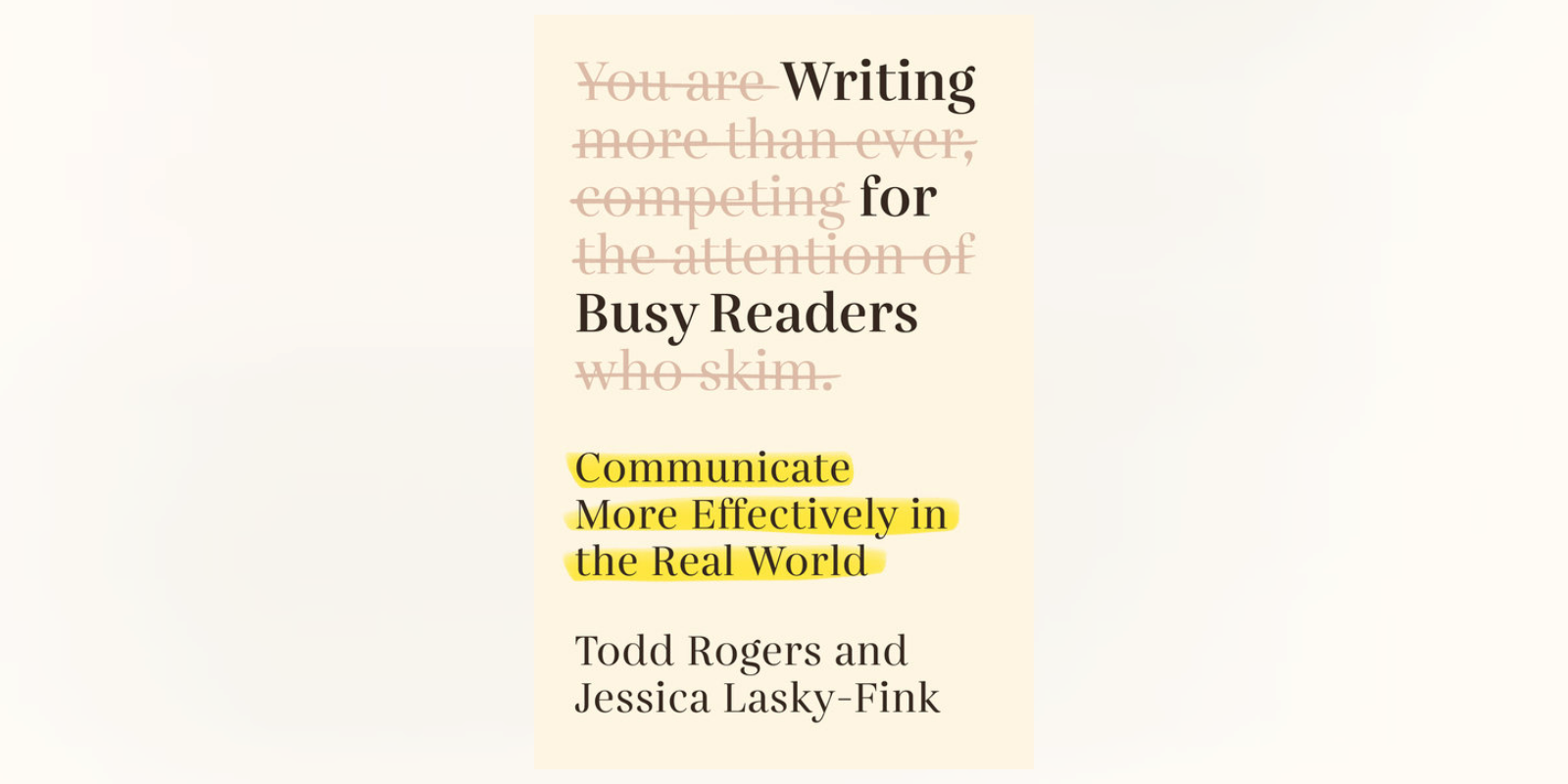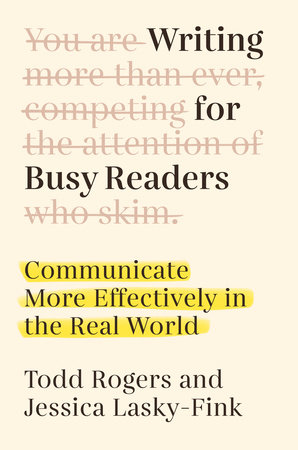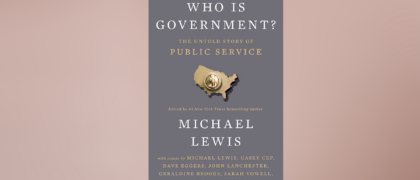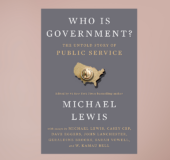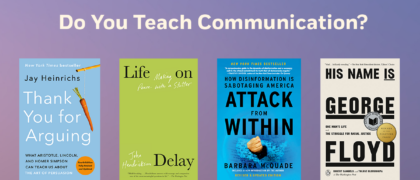Todd Rogers and Jessica Lasky-Fink offer the most valuable practical writing advice today. Building on their own research in behavioral science, they outline cognitive facts about how people actually read and distill them into six principles that will transform the power of one’s writing:
- Less is more
- Make reading easy
- Design for easy navigation
- Use enough formatting, but no more
- Tell readers why they should care
- Make responding easy
Including many real-world examples, a checklist and other tools, this guide will make students more successful and productive communicators.
This is a book we never planned to write.
There are already plenty of how-to books about the writing process. Nobody we know, ourselves included, would normally think to read a book about writing. There is also something peculiar about the very concept of writing about writing. It seems circular and self-referential: “Writing about writing” sounds a lot like, say, “singing about singing.” Then gradually, almost without our noticing, we became convinced that there is a genuine need for a different kind of book about writing—one that explains, point by point, the proven techniques for communicating effectively with any recipient, any reader. We also recognized a need to focus specifically on the busy reader, because we live in an unprecedented age of media saturation and information overload. Modern writers need extra help breaking through all the distractions.
What you will read about in these pages draws on a vast body of research, much of it by us. It is also informed by many years of our professional and personal experiences. Todd spent a decade working on the science of writing to busy voters. Both of us worked on the science of writing to busy families. During the pandemic, we advised state and local leaders on how to write to busy constituents. Step by step, we realized that some principles of effective writing are nearly universal and yet are not well-known.
Viewed this way, the analogy with singing carries a quite different message. Singing is a simple thing that anyone can do but that most of us don’t do particularly well. Great singers learn not just by listening to others and making subjective, aesthetic judgments. They train and improve by following well-developed techniques that are grounded in objective studies of anatomy, acoustics, and human perception. So it is with writing. Today, we know what goes on inside a busy reader’s brain. We know how a reader’s eyes move as they respond to different stimuli. We know why certain types of writing draw a reader’s focus while others tend to get lost in the fog of distraction and competition for attention. We wrote this book to share these important, potentially life-changing insights. It is a guide to the science of writing so busy people read and respond.
THE PATH FROM IDEA TO ACTION
The principles of this book apply to everyone, because we are all writers. More and more of our lives are conducted via text, email, and other digital messages. All of that is layered on top of the older types of practical writing such as office reports, school updates, registration forms, newsletters, and notifications. These types of practical communications generally ask readers to perform a task or to engage with a piece of information. Sometimes we want readers to understand details about upcoming plans, vaccination schedules, disclosures, or policy changes. Other times we need readers to take action, like providing feedback, answering a question, completing a form, or scheduling a meeting.
You may not think of yourself as a writer, but consider this: Has a day ever gone by when you didn’t write anything? A text message is writing. A work email is writing. A Facebook post or a tweet is writing. An update on Slack is writing. Even a to- do list on the fridge is a form of writing—in this case, a message to your future, busy self. All of those things are more effective if they are written in ways that account for how busy people read. Such communications are pretty much inescapable in modern life, which is why we say that we are all writers. Equally important, we are all readers, too. We wear both hats. And these days, most of us are busy readers, faced with many conflicting demands for our time.
Effective writing makes life easier, more pleasant, and more productive both for the writer and for the reader. It is a power—an almost magical power that can transmit a thought or goal from your head into someone else’s head, and then inspire them to act in response. It breaks through the cloud of distraction that surrounds busy people. And it is something that anyone can do. Once you learn the principles behind effective writing, that power is yours.
This book will set out the six fundamental principles of effective writing and provide guidance on how to put them to work. But first, we want to be clear about what effective writing is, and why it is such an important but misunderstood skill.
• Effective writing has a well-defined purpose. Writing is how you share ideas that are important to you. It is also how you convince other people to do what you want them to do, whether that means reading a memo, picking the restaurant where you’ll have lunch, or signing up to volunteer at a community event. Effective writing gets through to the reader, even the busy reader whose own goal may be to stop reading and move on as quickly as possible. If you lose your reader, it’s not their fault; it is your job as the writer to capture their attention and keep them engaged.
• Effective writing helps the writer as well as the reader. Most of us write for practical reasons dozens, maybe hundreds, of times each week. So we must be good at it, right? Turns out, we’re far worse at practical writing than we think we are. Too often, our messages go unanswered. We get late or incomplete responses. Seemingly simple exchanges become complicated and confusing. The principles of effective writing help you get your point across more clearly and quickly so that things happen when you want them to. Being clear with your words also forces you to be clear in your own thinking. It brings your ideas and goals into sharper focus.
• Effective writing is not the same as beautiful writing. Expressive, literary writing is a time-honored craft, but a highly subjective one that can take a lifetime to master. It is often consumed as a form of recreation by people who have the time and who have already decided to set aside other tasks so that they can indulge themselves in their reading. Often, beautiful writing is intentionally demanding and multilayered. Effective writing, on the other hand, is a skill that anyone can master, and it has a very specific goal: clearly convey specific information to busy people and make it easy for them to understand and respond.
• There is a rigorous science underlying the rules of effective writing. We can argue endlessly about what kind of writing is most beautiful, but effective writing is not so subjective. There are well-defined strategies, based on the science of human cognition, that offer guidance on how to be more effective writers. We have looked at hundreds of scientific studies and conducted our own research to see what works. We also draw lessons from our two careers as writers and communicators. This book codifies all of that knowledge into a set of principles designed to be applicable to all forms of practical communication.
• Effective writing is read in a context. Our six principles of effective writing (and the rules of application associated with each of them) can help anyone become a more effective writer and communicate more clearly with a busy reader. The underlying science is the same in every situation. How to put the principles into action will depend heavily on context, however. Each writer has a different voice and life experience; each reader has different expectations, assumptions, and biases. In each section of the book we will discuss the contextual considerations that we all face in the real world.
HOW TO USE THIS BOOK
In keeping with our own advice and guidance, we have structured this book to be as direct and effective as possible for you, the busy reader. To get the most out of it, though, we encourage you to think about your own goals as a writer and to understand what this book is designed to do.
In school we were taught the fundamentals of formal writing, including proper grammar, spelling, punctuation, and prose. Those of us raised in the American school system began learning about organization and flow, word choice, and voice in elementary school. In high school, we were taught the art of the five-paragraph essay and crafting thesis statements. These are critical skills, but much of the formal writing we learned in school is irrelevant or counterproductive for real-world practical writing.
As a result, most of us learn practical writing informally. We pick up strategies here and there by observing that some messages receive prompt responses, and for others we continue to wait for responses. Proper grammar and punctuation, full sentences, and appropriate word choice are almost always useful.
But if you email your company’s leadership team a five-paragraph essay about how a client meeting went, they are unlikely to read it, no matter how beautiful the prose. These dueling styles—formal writing and practical writing—coexist uncomfortably in our heads, and most of us have never been trained how to combine them into effective writing.
In this book, you will not find recycled lessons on how to write well, à la the classic book The Elements of Style by Strunk and White. You also will not find simplistic, inflexible lists of writing rules, as you will find in some of the more modern how-to books on efficient (rather than effective) writing. Rather, our principles derive from the sciences of psychology and human behavior, blended with a social understanding that most people have limited time and attention.
Effective writing reflects an understanding of the science of how busy readers interact with our writing. This book is written with that interaction in mind. To distill the science, we have reviewed research in cognitive psychology, social psychology, behavioral economics, neuroscience, communications, literacy, teaching and learning, marketing, time management, and more. We’ve also conducted hundreds of randomized experiments with collaborators to understand what works and what doesn’t.
Randomized experiments start with a large group of people. In a typical experiment, some people are randomly selected to receive a standard message (they are the “control group”), while others are randomly selected to receive the standard message plus a specific revision or modification (they are the “treatment group”). We then observe what fraction of each group does whatever the message was designed to prompt them to do: reply, click on a link, show up at an event, donate, and so on. By randomly selecting which participants receive each message, we can isolate the effect of the specific revision on the behavior. All the guidance we offer in this book comes from these types of studies. Note, however, that randomized experiments can provide only a broad snapshot of human behavior. They reveal tendencies over groups but cannot predict individual behavior. That said, they are highly valuable tools, the gold standard in research for helping us understand what works in the real world.
As we completed this book, we couldn’t help applying some of these psychological insights to ourselves. We often joke that we decided the best way to help people write shorter, more effective messages was to write a whole book about it. We worked hard to keep this book as concise as possible, but we found that a full understanding could not be conveyed in just a short enumeration of our six core principles. Recognizing this seeming irony, we structured our book to be easy to navigate for busy readers who want to skip around—although we suggest you read it straight through.
However you approach this book, we hope it teaches useful skills as well as the illuminating science underlying them. Writing effectively helps writers achieve their goals. And our goal for this book is to help you achieve yours, in everything you write

© Tony Rinaldo Photography
Todd Rogers is a Professor of Public Policy at Harvard University, where he has won teaching awards for the past six consecutive years. He is a behavioral scientist and the co-founder of the Analyst Institute and Everyday Labs. His opinion pieces have appeared in the New York Times, the Los Angeles Times, and Politico, among others.

© Noelia S. Negri
Jessica Lasky-Fink is the Research Director at The People Lab, based at the Harvard Kennedy School. Her research focuses on improving the delivery of government programs and services.

